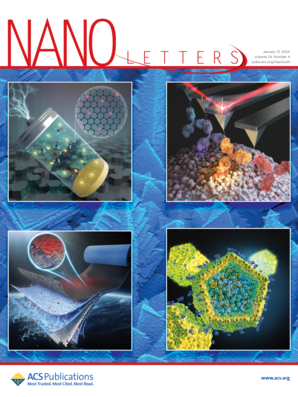The In Situ Assembly of an Equipotential Cathode for Nitrite Enrichment Enabling Electrochemical Nitrate Reduction to N2
IF 9.6
1区 材料科学
Q1 CHEMISTRY, MULTIDISCIPLINARY
引用次数: 0
Abstract
Electrocatalytically reducing NO3– to N2 is of great significance for environmental remediation and global nitrogen cycling. However, it is currently hindered by low N2 selectivity since adsorbate N-intermediates are hard to migrate and couple each other during the N–N coupling step. Herein, an in situ assembly strategy was taken to attach Pd@Cu2O nanoparticles with CuO nanowire arrays to form an equipotential cathode CuO-Pd@Cu2O, which optimized N2 selectivity to 91%, much higher than that of directly loaded Pd–Cu cathode (55%). Theoretical calculations combined with in situ spectroscopies demonstrated that the equipotential cathode can shield the electric field and enrich NO2– intermediate inside. Meanwhile, a unique reaction pathway was revealed that the enriched NO2– can directly couple with *N and also tune the Pd d-band center, avoiding the hurdles in N–N coupling. The approach here provides a new perspective in cathode design and a mechanistic understanding for the N–N coupling reaction.

亚硝酸盐富集等电位阴极的原位组装使电化学硝酸还原为N2
电催化还原NO3 -为N2对环境修复和全球氮循环具有重要意义。然而,由于吸附的n -中间体在N-N耦合步骤中难以迁移和相互耦合,目前受到低N2选择性的阻碍。本文采用原位组装策略,将Pd@Cu2O纳米颗粒与CuO纳米线阵列连接形成等电位阴极CuO-Pd@Cu2O,使N2选择性达到91%,远高于直接负载Pd-Cu阴极(55%)。理论计算结合原位光谱分析表明,等电位阴极可以屏蔽电场,富集内部的NO2 -中间体。同时,揭示了一种独特的反应途径,即富集的NO2 -可以直接与*N偶联,并调节Pd - d带中心,避免了N - N偶联中的障碍。该方法为阴极设计提供了新的视角,并对N-N偶联反应的机理有了新的认识。
本文章由计算机程序翻译,如有差异,请以英文原文为准。
求助全文
约1分钟内获得全文
求助全文
来源期刊

Nano Letters
工程技术-材料科学:综合
CiteScore
16.80
自引率
2.80%
发文量
1182
审稿时长
1.4 months
期刊介绍:
Nano Letters serves as a dynamic platform for promptly disseminating original results in fundamental, applied, and emerging research across all facets of nanoscience and nanotechnology. A pivotal criterion for inclusion within Nano Letters is the convergence of at least two different areas or disciplines, ensuring a rich interdisciplinary scope. The journal is dedicated to fostering exploration in diverse areas, including:
- Experimental and theoretical findings on physical, chemical, and biological phenomena at the nanoscale
- Synthesis, characterization, and processing of organic, inorganic, polymer, and hybrid nanomaterials through physical, chemical, and biological methodologies
- Modeling and simulation of synthetic, assembly, and interaction processes
- Realization of integrated nanostructures and nano-engineered devices exhibiting advanced performance
- Applications of nanoscale materials in living and environmental systems
Nano Letters is committed to advancing and showcasing groundbreaking research that intersects various domains, fostering innovation and collaboration in the ever-evolving field of nanoscience and nanotechnology.
 求助内容:
求助内容: 应助结果提醒方式:
应助结果提醒方式:


